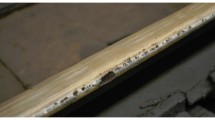Abstract—
The wheel–rail interaction during rolling along a straight railroad track section with and without the rail flattening effect is modeled. Rail flattening is used to describe a defect that occurs in the area of a welded rail joint. The model takes into account an increase in the load during dynamic impactless interaction in the region of welded joints, change in the configuration of the contact region, and existence of stick and slip subregions during rolling. The contact characteristics and stress states of the rail are compared for different relative longitudinal slip and in the presence and absence of track flattening of two characteristic sizes. An analysis of internal stresses shows that an increase in the relative longitudinal slip leads to an increase in the maximal tangential stresses near the surface. The results of analyzing contact pressures and tangential stresses show that, with an increase in the flattening depth, the depth wise distribution of maximal tangential stresses becomes more uniform.






Similar content being viewed by others
REFERENCES
Goryacheva, I.G., Torskaya, E.V., and Dobychin, M.N., Modeling the conditions for the formation of contact-fatigue damage to the tread surface, in Kontaktno-ustalostnye povrezhdeniya koles gruzovykh vagonov (Contact-Fatigue Damage to Freight Cars Wheels), Zakharov, S.M., Ed., Moscow: INTEKST, 2004, pp. 58–113.
Kossov, V.S., Krasnov, O.G., and Akashev, M.G., The impact of deformation in the zone of welded joints on the force action of the rolling stock on the track, Vestn. Inst. Zheleznodor. Transp., 2020, Vol. 79, no. 1, pp. 9–16.
Instructions: Rail Defects. Classification, catalog and parameters of defective and sharply defective rails, Approved October 23, 2014.
Mikheev, G.V., Pogorelov, D.Yu., and Rodikov, A.N., Methods for wheelset dynamics modeling taking into account elasticity, Vestn. Bryan. Tekh. Univ., 2019, no. 4 (77), pp. 40–51.
Xu, J. et al., Geometry evolution of rail weld irregularity and the effect on wheel-rail dynamic interaction in heavy haul railways, Eng. Fail. Anal., 2017, vol. 81, pp. 31–44.
Bezgin, N.Ö., Development of a new and an explicit analytical equation that estimates the vertical dynamic impact loads of a moving train, Proc. Eng., 2017, vol. 189, pp. 2–10.
Kalker, J.J., A fast algorithm for the simplified theory of rolling contact, Veh. Syst. Dyn., 1982, vol. 11, no. 1, pp. 1–13.
Goldstein, R.V. et al., Solutions of three-dimensional rolling problems with slip and adhesion by variational methods, Usp. Mekh., 1982, vol. 5, nos. 3–4, pp. 60–102.
Meshcheryakova, A.R. and Goryacheva, I.G., Stress state of elastic bodies with an intermediate layer in rolling contact with slip, Phys. Mesomech., 2021, vol. 24, pp. 441–450.
Zakharov, S.M. and Torskaya, E.V., Approaches to modeling occurrence of rolling contact fatigue damages in rails, Vestn. Inst. Zheleznodor. Transp., 2018, vol. 77, no. 5, pp. 259–268.
Ekberg, A., Kabo, E., and Andersson, H., An engineering model for prediction of rolling contact fatigue of railway wheels, Fatigue Fract. Eng. Mater. Struct., 2002, no. 10, pp. 899–909.
Johnson, K.L., Contact Mechanics, Cambridge: Cambridge Univ. Press, 1985.
Vershinskij, S.V., Danilov, V.N., and Husidov, V.D., Dinamika vagona (Wagon Dynamics), Moscow: Transport, 1991.
Rabotnov, Yu.N., Soprotivlenie materialov (Strength of Materials), Moscow: Fizmatgiz, 1962.
Daves, W. et al., A finite element model to simulate the physical mechanisms of wear and crack initiation in wheel/rail contact, Wear, 2016, vols. 366–367, pp. 78–83.
Funding
The study was funded by the Russian Foundation for Basic Research, Sirius University of Science and Technology, JSC Russian Railways, and Educational Fund Talent and Success, project no. 20-38-51 005.
Author information
Authors and Affiliations
Corresponding author
Additional information
Translated by S. Kuznetsov
About this article
Cite this article
Meshcheryakova, A.R., Tsukanov, I.Y. Influence of Flattening in the Zone of Welded Joints of Railroad Track on Contact Interaction in the Wheel–Rail System. J. Frict. Wear 43, 128–134 (2022). https://doi.org/10.3103/S1068366622020088
Received:
Revised:
Accepted:
Published:
Issue Date:
DOI: https://doi.org/10.3103/S1068366622020088




